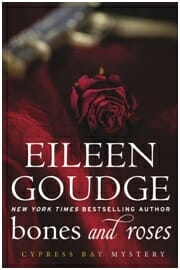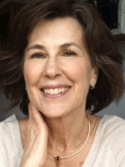I’d like to welcome author Eileen Goudge to The Book Designer. A traditionally published author, Eileen has decided to take the self-publishing route for her latest book and today she describes her self-publishing journey to us. I hope you enjoy it.
I have a terrible sense of direction. My husband thinks it’s funny that I get lost even with GPS. It’s not so funny when you’re the one driving south on a freeway when you ought to be headed north to the nearest airport, worried you’ll miss your flight. I’ve been known to scream at the GPS lady.
But every so often getting lost can turn out to be a positive. Like when I take a wrong turn that leads me down picturesque back roads. Who wouldn’t rather look out at cows grazing in fields or roadside produce stands than other cars and fast-food franchises?
But what happens when you take an unexpected turn in pursuing a career path? When I went from being traditionally published to becoming my own publisher, it was a direction I hadn’t planned on taking, and the journey has been one not unlike Dorothy’s by tornado to the Land of Oz.
It started innocently enough. I was having lunch at a restaurant with my author friend, Josie Brown. Josie had been traditionally published (we briefly shared the same agent, unbeknownst to either of us at the time) before she went indie. She’s now reaping the rewards. She’s gone from being relegated to piddling print runs—with the paycheck to match—to a six-figure income. She urged me to give it a go. I balked at first, arguing that it was too risky and besides, what did I know about DIY publishing?
A lot more than I realized, as it turns out.
First and foremost, I knew how to write. As a New York Times bestselling author of fifteen women’s fiction titles, I’ve had plenty of practice honing my craft and I’ve worked with some of the top agents, editors and publishers in the business.
I also knew people. When you’ve been in and around publishing as many years as I have, you’ve got what my husband calls a “solid gold Rolodex.” There were lots of people I could hire or call on for advice. (If you’re just starting out, it’s easy to make friends with other writers, thanks to all the social media outlets available. And writers, in my experience, are the most generous of souls. We all help one another because we know it takes a village. You won’t be out on a limb by yourself.)
I figured I’d learn the rest as I went along.
I won’t lie: It was hard work. In the beginning I felt like someone struggling to put together a child’s swing set without proper tools, having failed to notice the “some assembly required” in the instructions before ordering it. There were restless nights and fears of all that could go wrong. But I persisted. I’m stubborn. Once I make up my mind to do something, I see it through to the end.
The idea for my Cypress Bay mystery series came to me during a stroll on the beach. These days I make my home in New York City, but for some years I lived in the beautiful Northern California seaside town of Santa Cruz. I still go there once a year, for a month at a time, to hole up with my laptop and write. There’s nothing quite like gazing out at the sea or listening to the sound of waves for tapping into one’s creative wellspring.
The premise for Bones and Roses and the character of my amateur sleuth, Tish Ballard, popped into my head that day at the beach. I went back to the house I was staying at and sat down to hammer out an outline. It was love at first byte.
Several months later, I had a first draft. I showed it to two of my friends, both veteran readers and merciless critics. They were encouraging. I went back to the drawing board with their comments. In the meantime, I got busy assembling my dream team.
Signing With a Distributor
I signed with a distributor, INscribe Digital, which has an excellent track record. I didn’t see the need to shop around, given they were recommended by my friend, Josie, who’d worked with them on some of her titles.
They work on percentage—15%, the same commission I would’ve paid my agent—so I didn’t have to worry about being out of pocket. And INscribe has relationships with the various e-tailers I couldn’t hope to replicate; I knew the chances of my books being included in any special promotions were better with them than if I were acting alone. They also handle library distribution, and library sales had been a significant percentage of the overall sales of my traditionally published titles.
Finding a Book Cover Designer
 Next I set about finding a book designer. At first I was overwhelmed by the sheer number of designers to choose from. I looked at a ton of sample covers, and even ran a contest on 99designs.com that garnered over a hundred submissions, none of which was right for my book, before finally concluding my mom was right when she used to say, “You get what you pay for.” If you spend $200 on a book cover, chances are it won’t be in the same league as the covers of books on the New York Times bestseller list.
Next I set about finding a book designer. At first I was overwhelmed by the sheer number of designers to choose from. I looked at a ton of sample covers, and even ran a contest on 99designs.com that garnered over a hundred submissions, none of which was right for my book, before finally concluding my mom was right when she used to say, “You get what you pay for.” If you spend $200 on a book cover, chances are it won’t be in the same league as the covers of books on the New York Times bestseller list.
I ended up paying top dollar for a top designer, Mumtaz Mustafa, a senior art director at HarperCollins who also works freelance, and got my money’s worth. It was substantially more than the $200 I was quoted by another designer but still well within my budget, at under $2000 (including the fee for use of images), and the value it adds is priceless.
Readers DO judge a book by its cover, and if your book cover looks like a cheapo-depot special or something your teenage son Photoshopped in an afternoon using Shutterstock images, your otherwise worthy book will get passed over by discerning readers, I guarantee. Word of advice: If a designer has a crappy website that’s thin on samples (or has samples the size of a postage stamp), how can you trust him or her to give YOU the best book cover?
Editing
When the final draft of my novel was completed, I had an editor/copyediting team go over it. I went with Francine LaSala and Samantha Stroh Bailey of Perfect Pen Communications. Both are talented authors in their own right, as well as careful and methodical editors.
I’d worked with Francine on four of my traditionally published titles and knew the quality of her work. They did an excellent job and delivered in a timely fashion.
E-book Conversion
For the digitizing I went with another of my friend Josie’s recommendations: Polgarus Studio. Their fee, at under $100, was a bargain. As a note of interest, they’re physically located in Tasmania. Talk about the global village!
My Conclusions
Now, with the approach of the pub date for Bones and Roses (August 5th), I find myself reflecting on the journey I’ve taken. I learned a lot over the course of the past year and a half. I am no longer ignorant as to what, exactly, metadata is and does and what acronyms like BISAC (Book Industry Standards and Communication) stand for.
I mastered more social media platforms, with the help of my digital marketing “genie,” Lauren Lee, than I knew existed prior to this. Mostly through Twitter and Facebook, I forged invaluable connections with other authors and book bloggers.
I use TweetDeck so I can view multiple columns on one screen and see right away whenever my name or the titles of my books are mentioned. I’ve found I’m more comfortable retweeting when followers tweet nice things about me or one of my titles than I am canvassing the virtual highway wearing a sandwich board that reads BUY MY BOOK!
Also, the adage “You reap what you sow” applies to social media as well as life: I’m happy to urge people to buy my friends’ books because I genuinely want what’s best for my friends, and they, in turn, do the same for me. Remember, people who don’t know you are more inclined to listen when it’s a word-of-mouth thing than if you’re tooting your own horn. I do post/tweet notice of any special promotions and or new releases or when I have a new blog post, but I try to keep it within bounds.
The bottom line? Whatever comes of this or wherever I end up, I won’t regret taking the trip. If I hadn’t had the faith and courage to veer off the beaten path, I’d have remained remain stuck in a rut.
A brief description of Bones and Roses, Book One of my Cypress Bay mystery series can be found here on my website. I’m also sharing an excerpt here on Facebook.
I’d love to hear about any unexpected turns in your career path. What was the hardest part? What was the best part? Was it worth it in the end? Do you have any tips that could help others on a similar path?
 New York Time bestselling novelist Eileen Goudge wrote her first mystery, Secret of the Mossy Cave, at the age of eleven, and went on to pen the perennially popular Garden of Lies, which was published in 22 languages around the world, and numerous other women’s fiction tiles. Bones and Roses is the first book in her Cypress Bay Mysteries series. She lives in New York City with her husband, television film critic and entertainment reporter Sandy Kenyon. Keep connected with Eileen at her website, www.eileengoudge.com.
New York Time bestselling novelist Eileen Goudge wrote her first mystery, Secret of the Mossy Cave, at the age of eleven, and went on to pen the perennially popular Garden of Lies, which was published in 22 languages around the world, and numerous other women’s fiction tiles. Bones and Roses is the first book in her Cypress Bay Mysteries series. She lives in New York City with her husband, television film critic and entertainment reporter Sandy Kenyon. Keep connected with Eileen at her website, www.eileengoudge.com.
Photo: bigstockphoto.com. Amazon links contain my affiliate code.



